Sphinx extension to render the image by script or command
Project description
A sphinx extension to plot all kind of graph from script or command.
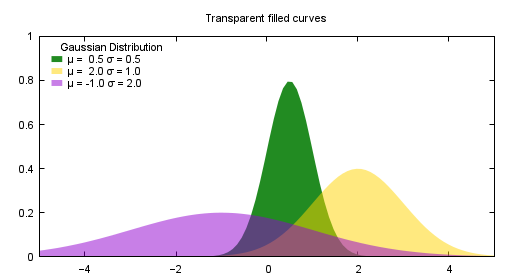
It’s could be generated by the foolowing plot directive.:
.. plot:: gnuplot
:caption: figure 3. illustration for gnuplot
:size: 500,300
set style fill transparent solid 0.5 noborder
set style function filledcurves y1=0
Gauss(x,mu,sigma) = 1./(sigma*sqrt(2*pi)) * exp( -(x-mu)**2 / (2*sigma**2) )
d1(x) = Gauss(x, 0.5, 0.5)
d2(x) = Gauss(x, 2., 1.)
d3(x) = Gauss(x, -1., 2.)
set xrange [-5:5]
set yrange [0:1]
set key title "Gaussian Distribution"
set key top left Left reverse samplen 1
set title "Transparent filled curves"
plot d1(x) fs solid 1.0 lc rgb "forest-green" title "μ = 0.5 σ = 0.5", \
d2(x) lc rgb "gold" title "μ = 2.0 σ = 1.0", \
d3(x) lc rgb "dark-violet" title "μ = -1.0 σ = 2.0"
1. Installing and setup
pip install sphinxcontrib-plot
And just add sphinxcontrib.plot to the list of extensions in the conf.py file. For example:
extensions = ['sphinxcontrib.plot']
2. Introduction and examples
In rst we we use image and figure directive to render image/figure. In fact we can plot anything in rst as it was on shell. For examples:
2.1 ditaa example
ditaa is a small command-line utility that can convert diagrams drawn using ascii art (‘drawings’ that contain characters that resemble lines like | / - ), into proper bitmap graphics. We could use the following directive to render the image generated by ditaa:
.. plot:: ditaa
:caption: figure 1. illustration for ditaa
+--------+ +-------+ +-------+
| | --+ ditaa +--> | |
| Text | +-------+ |diagram|
|Document| |!magic!| | |
| {d}| | | | |
+---+----+ +-------+ +-------+
: ^
| Lots of work |
+-------------------------+
Or plot it with parameters:
.. plot:: ditaa --svg
:caption: figure 2. illustration for ditaa with option
+--------+ +-------+ +-------+
| | --+ ditaa +--> | |
| Text | +-------+ |diagram|
|Document| |!magic!| | |
| {d}| | | | |
+---+----+ +-------+ +-------+
: ^
| Lots of work |
+-------------------------+
After convert using ditaa, the above file becomes:
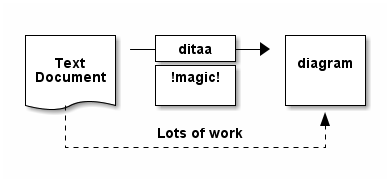
2.2 gnuplot example
Another example is gnuplot.:
.. plot:: gnuplot
:caption: figure 3. illustration for gnuplot
:size: 500,300
set style fill transparent solid 0.5 noborder
set style function filledcurves y1=0
Gauss(x,mu,sigma) = 1./(sigma*sqrt(2*pi)) * exp( -(x-mu)**2 / (2*sigma**2) )
d1(x) = Gauss(x, 0.5, 0.5)
d2(x) = Gauss(x, 2., 1.)
d3(x) = Gauss(x, -1., 2.)
set xrange [-5:5]
set yrange [0:1]
set key title "Gaussian Distribution"
set key top left Left reverse samplen 1
set title "Transparent filled curves"
plot d1(x) fs solid 1.0 lc rgb "forest-green" title "μ = 0.5 σ = 0.5", \
d2(x) lc rgb "gold" title "μ = 2.0 σ = 1.0", \
d3(x) lc rgb "dark-violet" title "μ = -1.0 σ = 2.0"
After convert using gnuplot, the above file becomes:

2.3 python example
Another example is mulplotlib.plot.
.. plot:: python
:caption: figure 4. illustration for python
import numpy as np
import matplotlib.pyplot as plt
fig = plt.figure()
fig.subplots_adjust(top=0.8)
ax1 = fig.add_subplot(211)
ax1.set_ylabel('volts')
ax1.set_title('a sine wave')
t = np.arange(0.0, 1.0, 0.01)
s = np.sin(2*np.pi*t)
line, = ax1.plot(t, s, color='blue', lw=2)
# Fixing random state for reproducibility
np.random.seed(19680801)
ax2 = fig.add_axes([0.15, 0.1, 0.7, 0.3])
n, bins, patches = ax2.hist(np.random.randn(1000), 50,
facecolor='yellow', edgecolor='yellow')
ax2.set_xlabel('time (s)')
plt.savefig("sphx_glr_artists_001.png")
After conversion using python, we could get the following image:
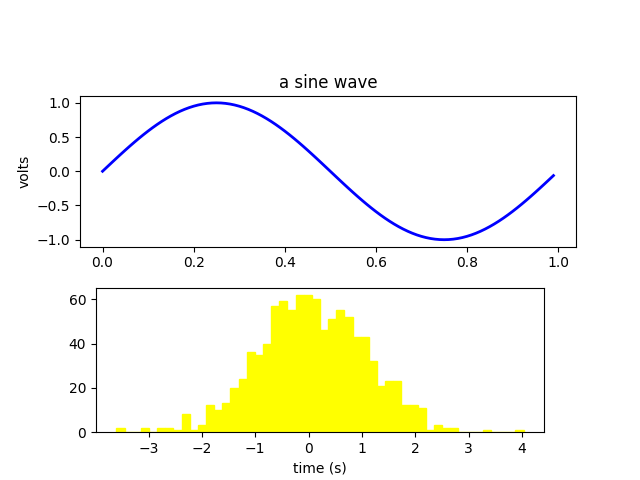
2.4 graphviz(dot) example
Another example is graphivx(dot), since we want to generate png image, we add the option in the command, it’s dot’s own option:
.. plot:: dot -Tpng
:caption: illustration for dot
digraph G {
subgraph cluster_0 {
style=filled;
color=lightgrey;
node [style=filled,color=white];
a0 -> a1 -> a2 -> a3;
label = "process #1";
}
subgraph cluster_1 {
node [style=filled];
b0 -> b1 -> b2 -> b3;
label = "process #2";
color=blue
}
start -> a0;
start -> b0;
a1 -> b3;
b2 -> a3;
a3 -> a0;
a3 -> end;
b3 -> end;
start [shape=Mdiamond];
end [shape=Msquare];
}
After convert using dot, the above file becomes:
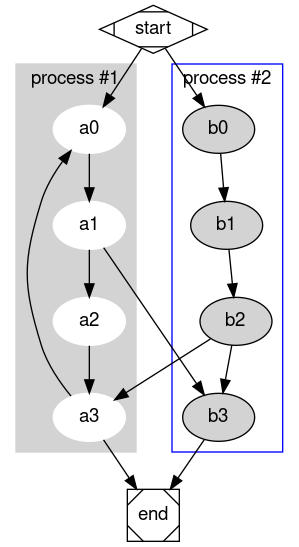
2.5 convert example
Another example is convert. You can write the command in the commnad line:
.. plot:: :caption: illustration for convert convert rose: -fill none -stroke white -draw 'line 5,40 65,5' rose_raw.png
This is the output:

or you can write most of the command line in the body:
.. plot::
:caption: illustration for convert
convert
-size 140x130 xc:white -stroke black \
-fill red -draw "path 'M 60,70 L 60,20 A 50,50 0 0,1 68.7,20.8 Z'" \
-fill green -draw "path 'M 60,70 L 68.7,20.8 A 50,50 0 0,1 77.1,23.0 Z'" \
-fill blue -draw "path 'M 68,65 L 85.1,18.0 A 50,50 0 0,1 118,65 Z'" \
-fill gold -draw "path 'M 60,70 L 110,70 A 50,50 0 1,1 60,20 Z'" \
-fill black -stroke none -pointsize 10 \
-draw "text 57,19 '10' text 70,20 '10' text 90,19 '70' text 113,78 '270'" \
piechart.jpg
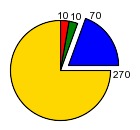
2.6 Other applications
In theory, All the command which could generate graph could be used after the directive “..plot::”. Please report it when you found anyone which works or doesn’t work.
3 Options
sphinxcontrib-plot provide some options for easy use.
3.1 command options
First of all, you can add any parameter after the command. sphinxcontrib-plot doesn’t know and interfere with it and only get the graph after it’s executed. for example:
.. plot:: ditaa --no-antialias -s 2
:caption: figure 1. illustration for ditaa with option.
+--------+ +-------+ +-------+
| | --+ ditaa +--> | |
| Text | +-------+ |diagram|
|Document| |!magic!| | |
| {d}| | | | |
+---+----+ +-------+ +-------+
: ^
| Lots of work |
+-------------------------+
3.2 sphinxcontrib-plot options
- size:
Control the output image size for gnuplot.
- suffix:
Control the output image format.
- convert:
After the image is generate, if you’d like to add some watermark, use convert to do that
- show_source:
for text generated iamge, if the source code is shown.
- caption:
The title for the image.
- name:
the reference name for the image.
Besdies that, you can use any options of figure and image since it is figure in nature.
For example:
.. plot:: gnuplot
:caption: figure 1. illustration for gnuplot with watermark.
:convert: -stroke red -strokewidth 2 -fill none -draw "line 100,100
200, 200"
:size: 900,600
:width: 600
plot [-5:5] (sin(1/x) - cos(x))*erfc(x)
3.2 global options
Please add the following option into you conf.py to designate defualt output file format for different targe.
gnuplot_format = dict(latex=’pdf’, html=’png’)
4. License
GPLv3
5. Changelog
1.0 Initial upload.
Project details
Release history Release notifications | RSS feed
Download files
Download the file for your platform. If you're not sure which to choose, learn more about installing packages.











